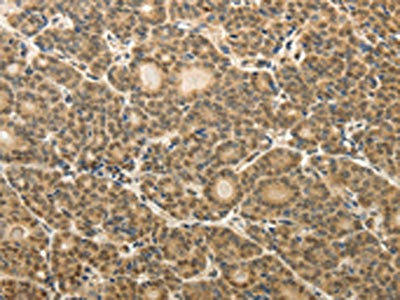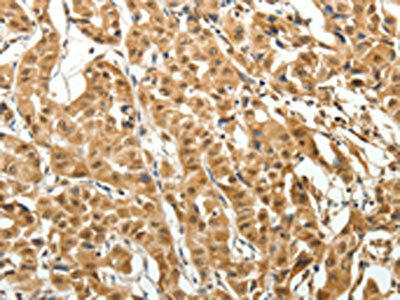Description
| Antibody Name: | MAP1A Antibody (PACO18950) |
| Antibody SKU: | PACO18950 |
| Size: | 50ul |
| Host Species: | Rabbit |
| Tested Applications: | ELISA, IHC |
| Recommended Dilutions: | ELISA:1:3000-1:10000, IHC:1:50-1:200 |
| Species Reactivity: | Human |
| Immunogen: | Synthetic peptide of human MAP1A |
| Form: | Liquid |
| Storage Buffer: | -20°C, pH7.4 PBS, 0.05% NaN3, 40% Glycerol |
| Purification Method: | Antigen affinity purification |
| Clonality: | Polyclonal |
| Isotype: | IgG |
| Conjugate: | Non-conjugated |
 | The image on the left is immunohistochemistry of paraffin-embedded Human thyroid cancer tissue using PACO18950(MAP1A Antibody) at dilution 1/40, on the right is treated with synthetic peptide. (Original magnification: x200). |
 | The image on the left is immunohistochemistry of paraffin-embedded Human lung cancer tissue using PACO18950(MAP1A Antibody) at dilution 1/40, on the right is treated with synthetic peptide. (Original magnification: x200). |
| Background: | This gene encodes a protein that belongs to the microtubule-associated protein family. The proteins of this family are thought to be involved in microtubule assembly, which is an essential step in neurogenesis. The product of this gene is a precursor polypeptide that presumably undergoes proteolytic processing to generate the final MAP1A heavy chain and LC2 light chain. Expression of this gene is almost exclusively in the brain. Studies of the rat microtubule-associated protein 1A gene suggested a role in early events of spinal cord development. |
| Synonyms: | microtubule-associated protein 1A |
| UniProt Protein Function: | MAP1A: structural protein involved in the filamentous cross- bridging between microtubules and other skeletal elements. Various serine residues may be phosphorylated by PKA.Protein type: Motility/polarity/chemotaxis; CytoskeletalChromosomal Location of Human Ortholog: 15q15.3Cellular Component: microtubule; microtubule associated complex; cytosolMolecular Function: protein binding; microtubule binding; structural molecule activityBiological Process: sensory perception of sound; microtubule cytoskeleton organization and biogenesis |
| UniProt Protein Details: | |
| NCBI Summary: | This gene encodes a protein that belongs to the microtubule-associated protein family. The proteins of this family are thought to be involved in microtubule assembly, which is an essential step in neurogenesis. The product of this gene is a precursor polypeptide that presumably undergoes proteolytic processing to generate the final MAP1A heavy chain and LC2 light chain. Expression of this gene is almost exclusively in the brain. Studies of the rat microtubule-associated protein 1A gene suggested a role in early events of spinal cord development. [provided by RefSeq, Jul 2008] |
| UniProt Code: | P78559 |
| NCBI GenInfo Identifier: | 313104325 |
| NCBI Gene ID: | 4130 |
| NCBI Accession: | P78559.6 |
| UniProt Secondary Accession: | P78559,O95643, Q12973, Q15882, Q9UJT4 |
| UniProt Related Accession: | P78559 |
| Molecular Weight: | 305,671 Da |
| NCBI Full Name: | Microtubule-associated protein 1A |
| NCBI Synonym Full Names: | microtubule-associated protein 1A |
| NCBI Official Symbol: | MAP1A |
| NCBI Official Synonym Symbols: | MAP1L; MTAP1A |
| NCBI Protein Information: | microtubule-associated protein 1A; MAP-1A; proliferation-related protein p80 |
| UniProt Protein Name: | Microtubule-associated protein 1A |
| UniProt Synonym Protein Names: | Proliferation-related protein p80Cleaved into the following 2 chains:MAP1A heavy chain; MAP1 light chain LC2 |
| Protein Family: | Methionine aminopeptidase |
| UniProt Gene Name: | MAP1A |
| UniProt Entry Name: | MAP1A_HUMAN |






